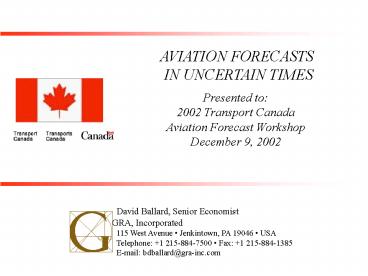David Ballard, Senior Economist - PowerPoint PPT Presentation
1 / 13
Title:
David Ballard, Senior Economist
Description:
Canadian airline market structure. Security environment and passenger perceptions ... Airline Yields High or low: High yields mean industry has market power and can ... – PowerPoint PPT presentation
Number of Views:33
Avg rating:3.0/5.0
Title: David Ballard, Senior Economist
1
AVIATION FORECASTS IN UNCERTAIN TIMES
Presented to 2002 Transport Canada Aviation
Forecast Workshop December 9, 2002
David Ballard, Senior Economist
GRA, Incorporated 115 West Avenue Jenkintown,
PA 19046 USA Telephone 1 215-884-7500 Fax
1 215-884-1385 E-mail bdballard_at_gra-inc.com
2
QUEST QUE CEST GRA?
- Founded in 1972
- Provides economic consultation services on
transport issues, primarily in aviation - Assignments from global clients in private and
public sectors - FAA
- NASA
- Airports
- Airlines
- Affiliated with GE Capital since 2000
- http//www.gra.aero
3
OVERVIEW AND INTRODUCTION
- Why forecast future activity?
- Planning
- Resource allocation
- Uncertainty in forecasts
- Uncertainty about the future course of the
drivers of aviation activity - Uncertainty about relationships among drivers
- Uncertainty about models
- What does future look like?
- What can future look like?
- What are important determinants and relationships
for the future environment? - Scenario-based analysis and planning
- What are plausible possible futures?
4
NORMAL FORECAST OF CANADIAN TOTAL REVENUE
PASSENGER ENPLANEMENTS
- Forecast based on relationships between past
activity and past drivers of activity, using
forecasts of drivers - In normal circumstances, forecasts are central
tendencies that become more uncertain or
variable, for a specific confidence level, over
time
5
UNCERTAINTY ABOUT FORECASTS MAY INCREASE
- Wider confidence bands and lower likelihood of
central tendency
6
FORECAST UNCERTAINTY AND UNCERTAIN SCENARIOS FOR
FUTURE
Optimistic Scenario Modest Scenario 1
Modest Scenario 2 Pessimistic
Scenario
- Increased uncertainty may reflect as yet unknown
changes in the relationship between drivers of
aviation activity and aviation activity itself.
7
SCENARIO-BASED PLANNING AND FORECASTING
- Scenario-based analysis most appropriate for
longer term assessments and uncertainties - Scenario-based analysis supports planning that is
more robust with respect to a variety of possible
future outcomes - Unclear micro linkages
- Planning for contingencies
- Characterizing complexities
- A supplement to normal forecasting methods and
applications
8
METHODOLOGICAL BASICS OF SCENARIO-BASED ANALYSIS
- Identify drivers of Canadian aviation activity
- Define a scenario space by choosing among
drivers and constraints affecting aviation
activity - Determine baseline or starting values for
activity measures and activity drivers - Specify constraints on analysis
- Enumerate possible scenarios
- Number of drivers or constraints (N)
- Number of values for each driver or constraint
(M) - Number of possible scenarios (MN)
- Identify plausible scenarios (in terms of
internal consistency of outcomes for chosen
drivers)
9
IDENTIFYING PLAUSIBLE SCENARIOS
- Not all possible combinations of values for
drivers and constraints make sense - Informed discussion and judgment a must, followed
by some independent review of choices - Extrapolate from scenarios for aviation activity
drivers and constraints to implications for
future aviation activity - Some example drivers/constraints
- Canadian GDP growth
- International GDP growth
- Canadian airline market structure
- Security environment and passenger perceptions
- Infrastructure constraints
- Quality/acceptance of substitutes for aviation
services
10
AN EXAMPLE OF SCENARIO DEVELOPMENT
- For a NASA assignment to develop a portfolio of
possible future environments for US aviation, GRA
and LMI chose four parameters from which to
create scenarios - GDP GrowthHigh or low Recognizes that economic
growth drives air travel and GDP growth is
driven by population and productivity - Airline YieldsHigh or low High yields mean
industry has market power and can be profitable,
attracting investment for modernization low
yields stimulate consumer demand, other factors
equal, but reduce margins. Yield levels driven
by demand/capacity balance, industry structure
and government regulation - Limits to Aviation System GrowthHigh or low
Barriers limit ability of industry to expand at
acceptable costs Limits include noise and
emissions rules, ATC and airport capacity,
airport access, security requirements, etc. - Substitutes to Commercial Air TravelBetter or
worse more attractive substitutes discipline
yields and reduce demand for commercial air
travel, while poorer substitutes provide pricing
power to carriers, other things equal includes
aviation and non-aviation substitutes
11
EXAMPLE MATRIX OF SELECTED SCENARIOS
Limits to Aviation Substitutes
to GDP Airline System Commercial Scenario
Name Growth Yields Growth Air Travel Economic
growth/ Airlines recover High High Many Poor Ec
onomic growth/ Consumer rules High Low Few Poor
Substitutes take share High Low Many Good Growt
h limits prevail Low High Many Poor Low Cost
Carriers (LCCs) dominate Low Low Few Good
12
CONCLUSION
- Normal forecasting may not be satisfactory or
sufficient in unusual environments - Scenario-based analysis and planning provides an
additional approach
13
MERCI!































